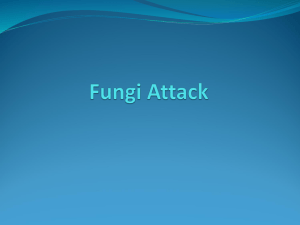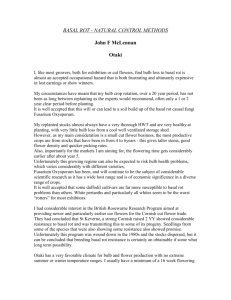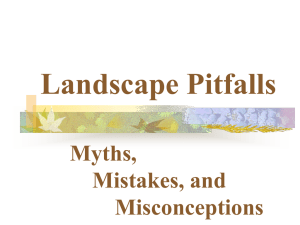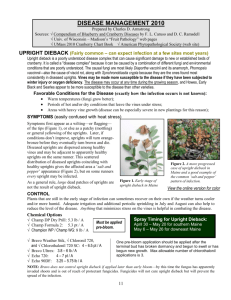StrawberriesandBlackRootRot
advertisement
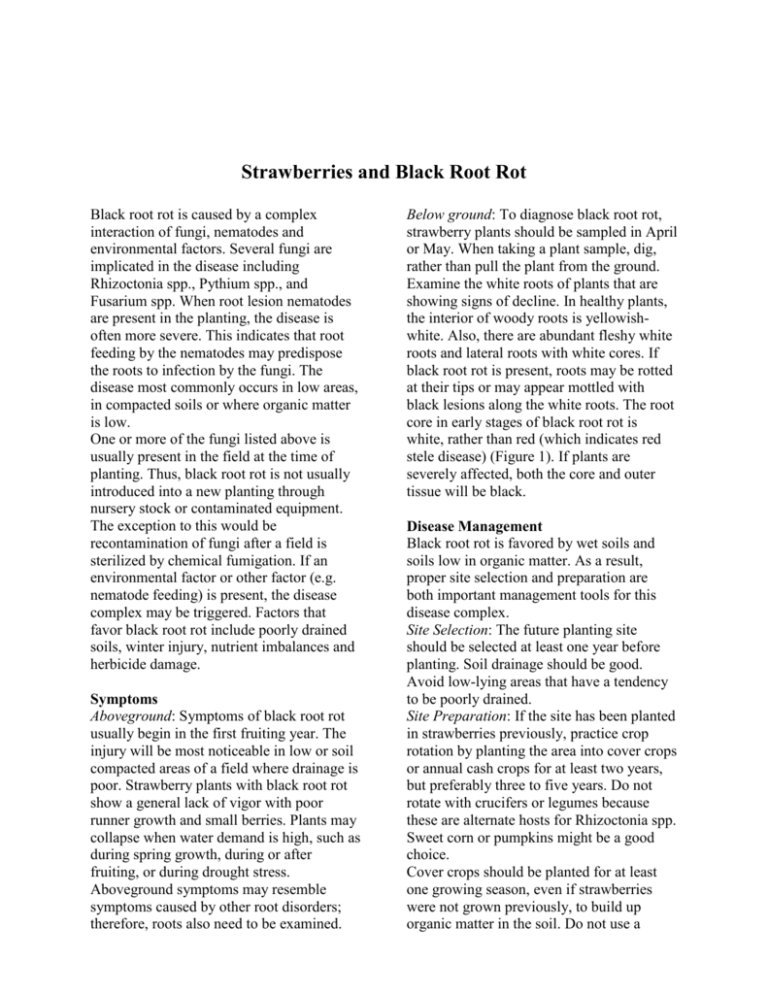
Strawberries and Black Root Rot Black root rot is caused by a complex interaction of fungi, nematodes and environmental factors. Several fungi are implicated in the disease including Rhizoctonia spp., Pythium spp., and Fusarium spp. When root lesion nematodes are present in the planting, the disease is often more severe. This indicates that root feeding by the nematodes may predispose the roots to infection by the fungi. The disease most commonly occurs in low areas, in compacted soils or where organic matter is low. One or more of the fungi listed above is usually present in the field at the time of planting. Thus, black root rot is not usually introduced into a new planting through nursery stock or contaminated equipment. The exception to this would be recontamination of fungi after a field is sterilized by chemical fumigation. If an environmental factor or other factor (e.g. nematode feeding) is present, the disease complex may be triggered. Factors that favor black root rot include poorly drained soils, winter injury, nutrient imbalances and herbicide damage. Symptoms Aboveground: Symptoms of black root rot usually begin in the first fruiting year. The injury will be most noticeable in low or soil compacted areas of a field where drainage is poor. Strawberry plants with black root rot show a general lack of vigor with poor runner growth and small berries. Plants may collapse when water demand is high, such as during spring growth, during or after fruiting, or during drought stress. Aboveground symptoms may resemble symptoms caused by other root disorders; therefore, roots also need to be examined. Below ground: To diagnose black root rot, strawberry plants should be sampled in April or May. When taking a plant sample, dig, rather than pull the plant from the ground. Examine the white roots of plants that are showing signs of decline. In healthy plants, the interior of woody roots is yellowishwhite. Also, there are abundant fleshy white roots and lateral roots with white cores. If black root rot is present, roots may be rotted at their tips or may appear mottled with black lesions along the white roots. The root core in early stages of black root rot is white, rather than red (which indicates red stele disease) (Figure 1). If plants are severely affected, both the core and outer tissue will be black. Disease Management Black root rot is favored by wet soils and soils low in organic matter. As a result, proper site selection and preparation are both important management tools for this disease complex. Site Selection: The future planting site should be selected at least one year before planting. Soil drainage should be good. Avoid low-lying areas that have a tendency to be poorly drained. Site Preparation: If the site has been planted in strawberries previously, practice crop rotation by planting the area into cover crops or annual cash crops for at least two years, but preferably three to five years. Do not rotate with crucifers or legumes because these are alternate hosts for Rhizoctonia spp. Sweet corn or pumpkins might be a good choice. Cover crops should be planted for at least one growing season, even if strawberries were not grown previously, to build up organic matter in the soil. Do not use a Figure 1. Strawberry Roots legume if black root rot is of concern. Cover crops include annual ryegrass, sudan grass and sorghum/sudan (Sudex). If the site selected does not have good soil drainage, the strawberry planting should be established on raised beds. The raised beds will allow excess soil water to drain from the strawberry root system, creating an environment less favorable to the diseasecausing fungi. In addition, less soil compaction will occur near the root system. Soil tests for fertility and pH should be conducted during site preparation. Fertilizer and/or lime should be added before or during planting based on the results. Pre-plant soil fumigation is often recommended for control of soil fungi and nematodes. However, there have been mixed results after fumigation with regard to black root rot. In some instances, black root rot has been reported to build up more quickly in fumigated soils than in nonfumigated soils. Researchers suspect that the reason for this may be that when the soil is sterilized by fumigation, beneficial or competitive soil microorganisms are eliminated. In their absence, Rhizoctonia and other fungi involved in the black root rot complex may increase more rapidly. Planting: Use only healthy, white rooted plants which have been purchased from a reputable nursery. There are no strawberry varieties, at this time, that are resistant to black root rot however, some varieties appear to be more tolerant than others. In varietal trials conducted on infested soils in New York, Raritan, Lester and Sparkle showed more tolerance than Blomidon and Honeoye. After Planting: Always use cultural practices which favor good plant growth and development. A soil and/or tissue analysis should be performed each year to determine optimum fertilizer applications. Try to minimize soil compaction created by equipment and cultural practices. Avoid over or under irrigation of the strawberry field. Strawberry plants should be mulched in late fall to prevent winter injury, which predisposes plants to black root rot. In particular, compacted, wet soils tend to heave more during the winter if mulching is insufficient. For pesticide recommendation, call UConn Home and Garden Education Center at 877-486-6271. References: Figure 1. Comparison of root structures of healthy plants and those infected with red stele or black root rot. Adapted from Soil-borne Diseases of Strawberries in New York State by Arneson, PA. and A.J. Braun. Cornell Coop Ext. Info Bull. No. 73. Pritts, M. and D. Handley (eds.). 1991. Bramble Production Guide. Northeast Regional Agricultural Engineering Service Pub. No. NRAES-35. 189 pp. Available from UConn Department of Natural Resources Management and Engineering Prepared by: Lorraine M. Los, Fruit Crops IPM Coordinator and M. Lee Schroeder, Former Small Fruit IPM Coordinator, University of Connecticut. Revised by Carol Quish, UConn Home and Garden Education Center 2005. The information in this material is for educational purposes. The recommendations contained are based on the best available knowledge at the time of printing. Any reference to commercial products, trade or brand names is for information only, and no endorsement or approval is intended. The Cooperative Extension system does not guarantee or warrant the standard of any product referenced or imply approval of the product to the exclusion of others which also may be available. All agrochemicals/pesticides listed are registered for suggested uses in accordance with federal and Connecticut state laws and regulations as of the date of printing. If the information does not agree with current labeling, follow the label instructions. The label is the law. Warning! Agrochemicals/pesticides are dangerous. Read and follow all instructions and safety precautions on labels. Carefully handle and store agrochemicals/pesticides in originally labeled containers immediately in a safe manner and place. Contact the Connecticut Department of Environmental Protection for current regulations. The user of this information assumes all risks for personal injury or property damage. Issued in furtherance of Cooperative Extension work, Acts of May 8 and June 30, 1914, in cooperation with the U.S. Department of Agriculture. Kirklyn M. Kerr, Director, Cooperative Extension System, The University of Connecticut, Storrs. The Connecticut Cooperative Extension System offers its programs to persons regardless of race, color, national origin, sex, age or disability and is an equal opportunity employer.
